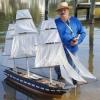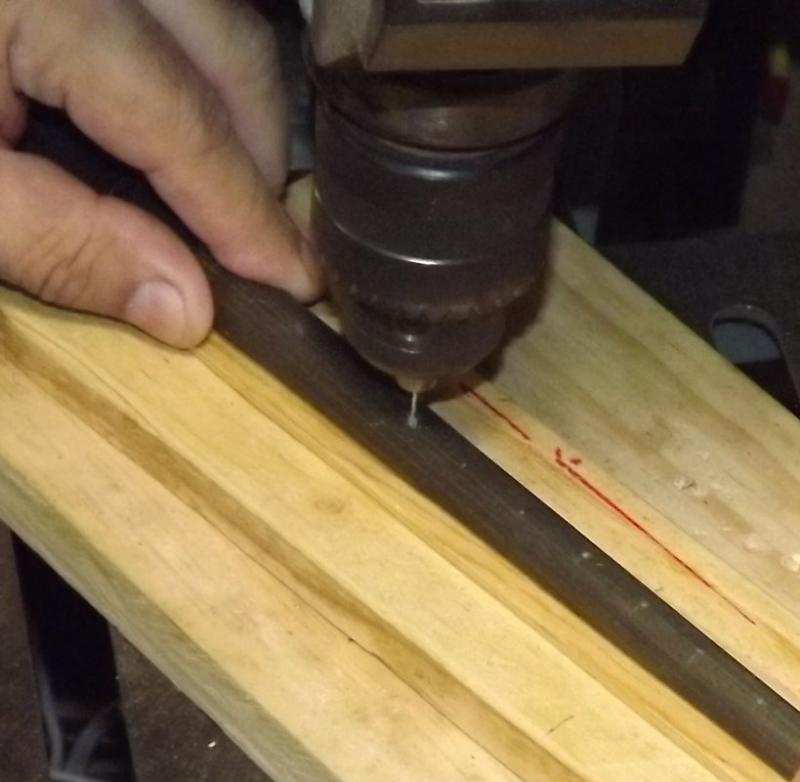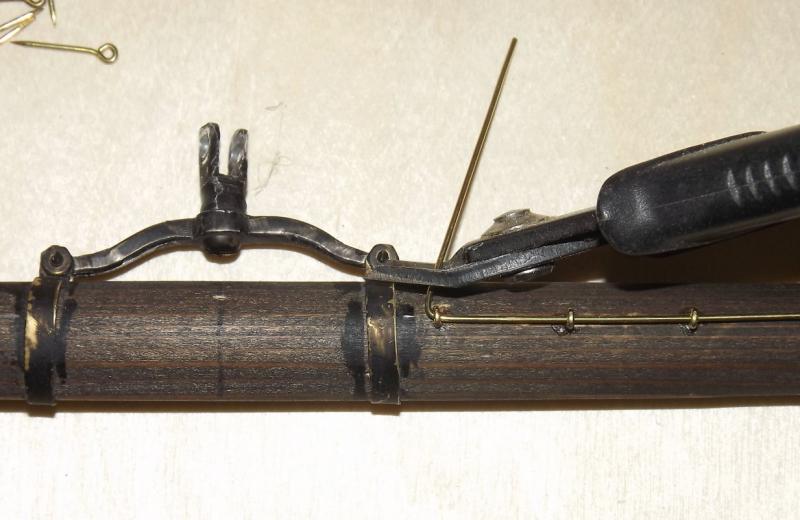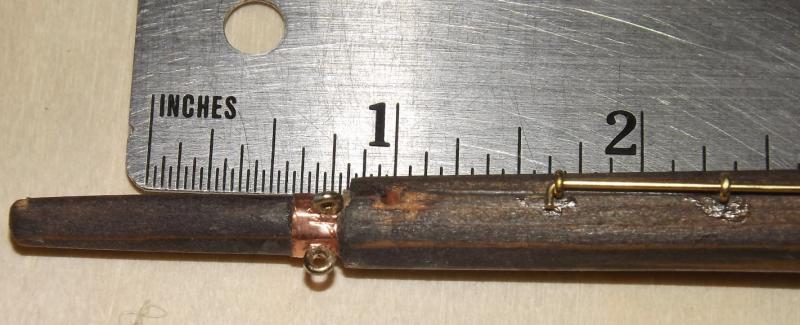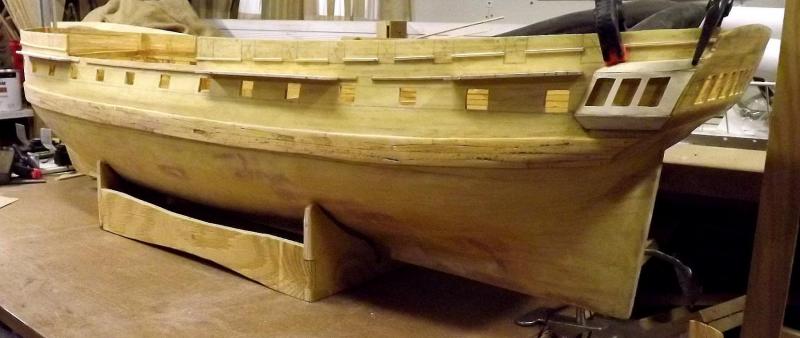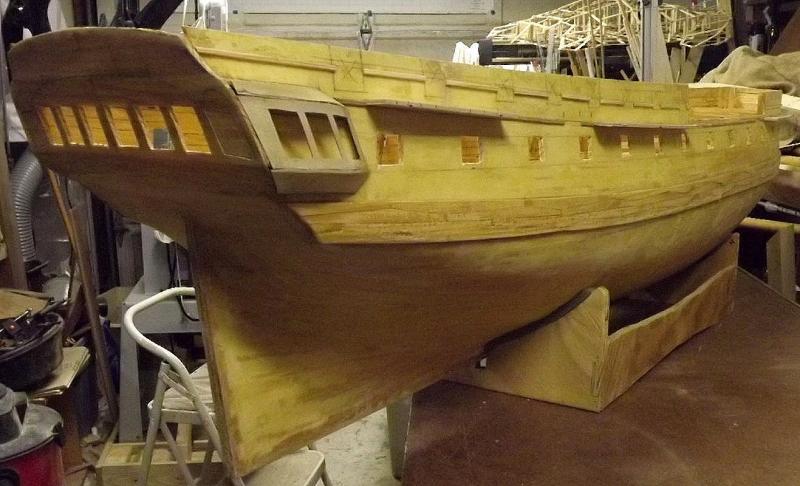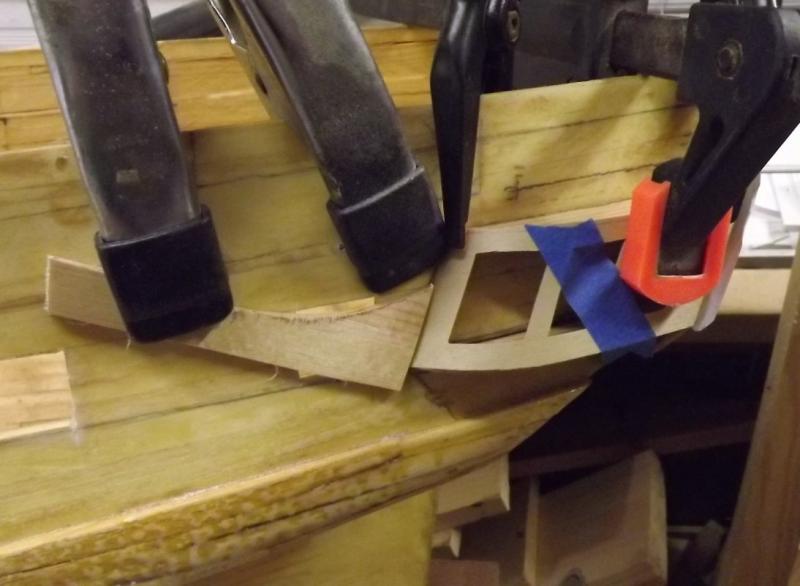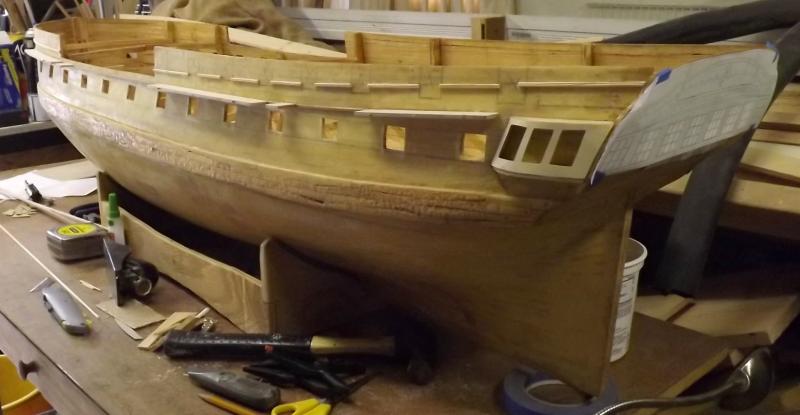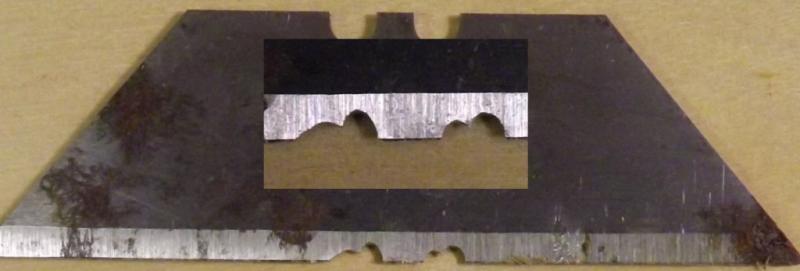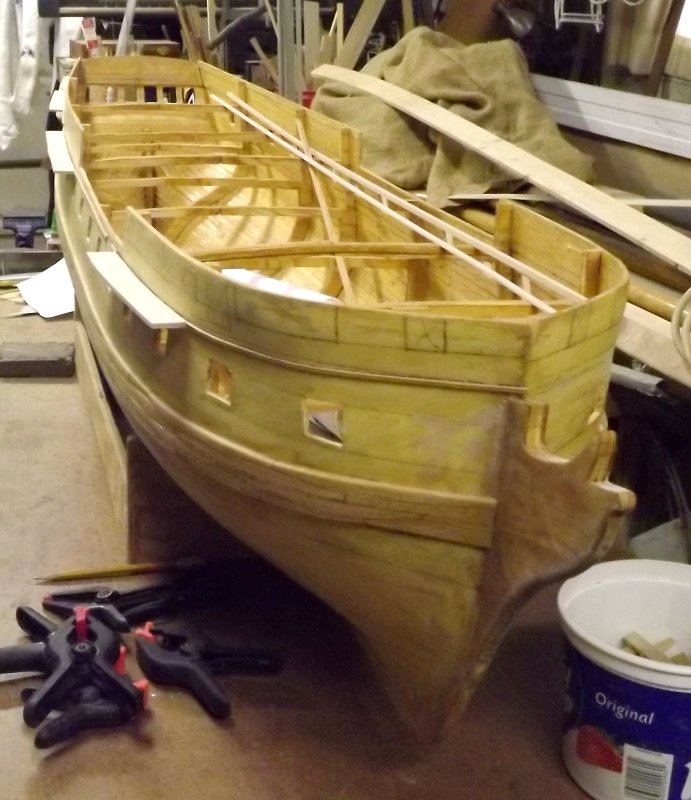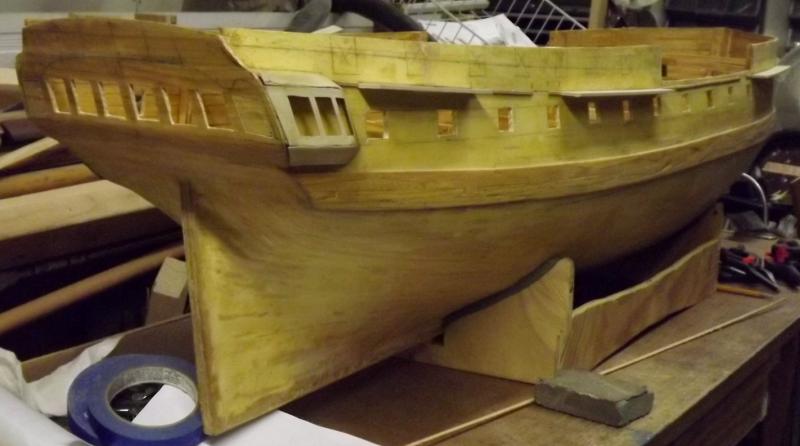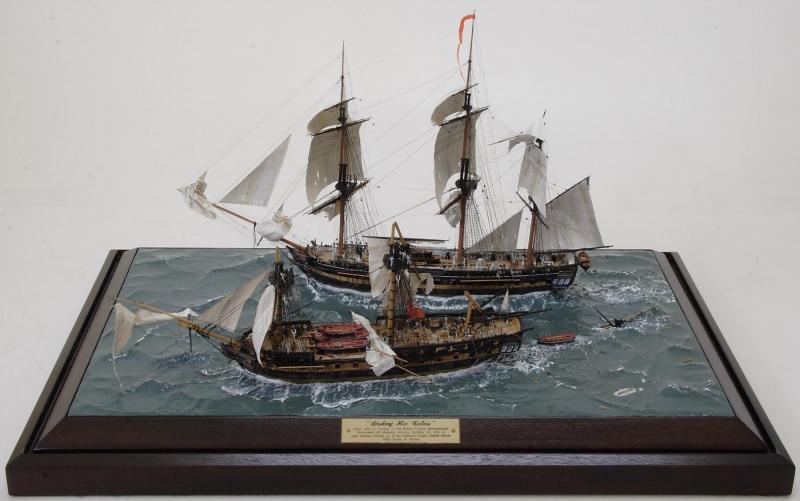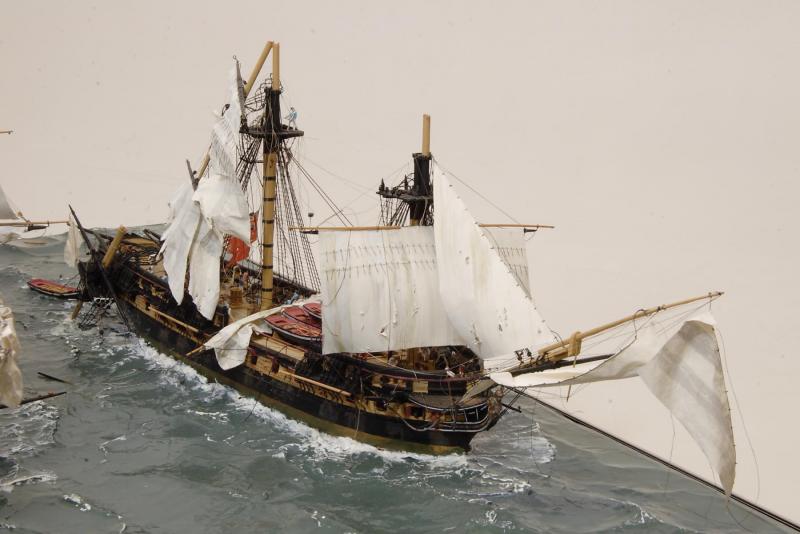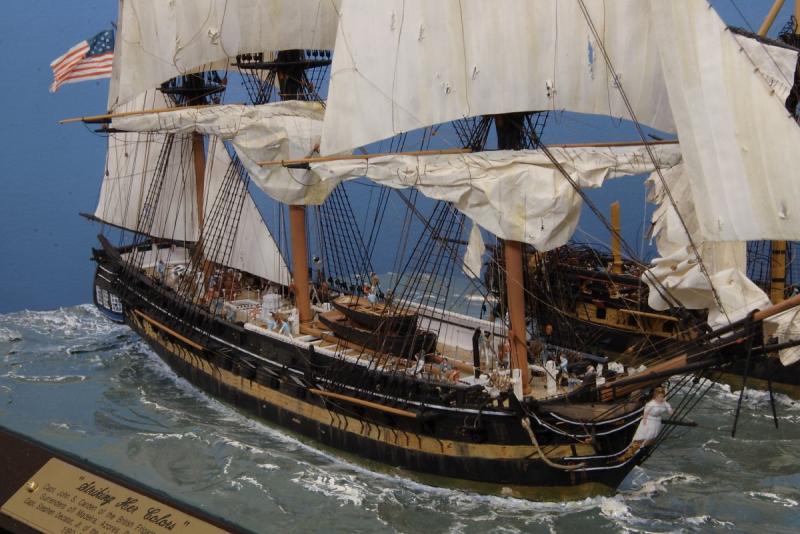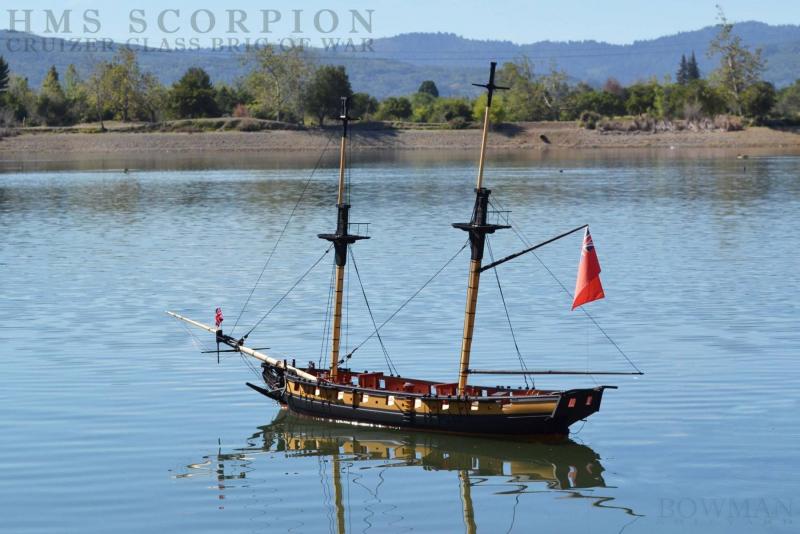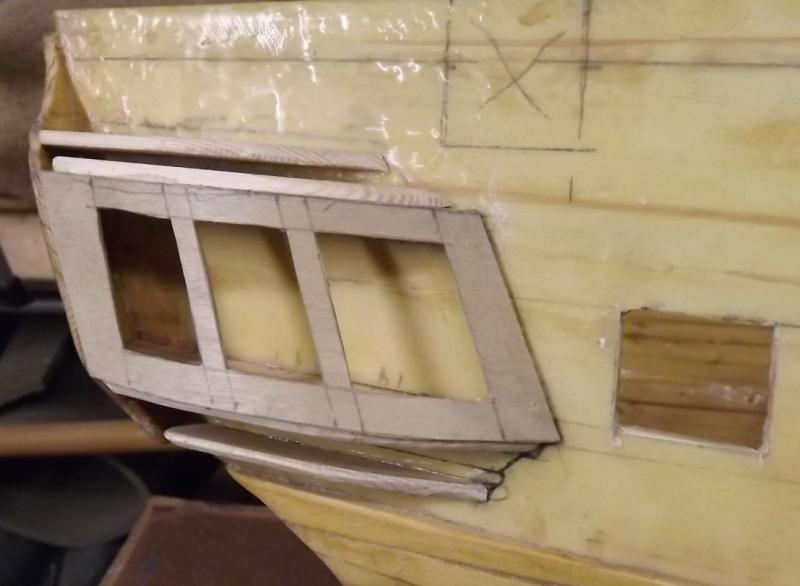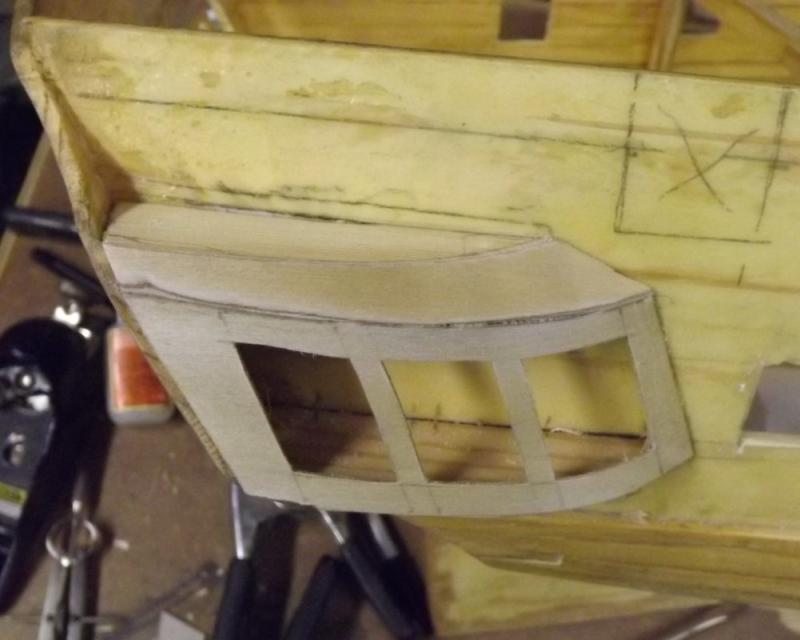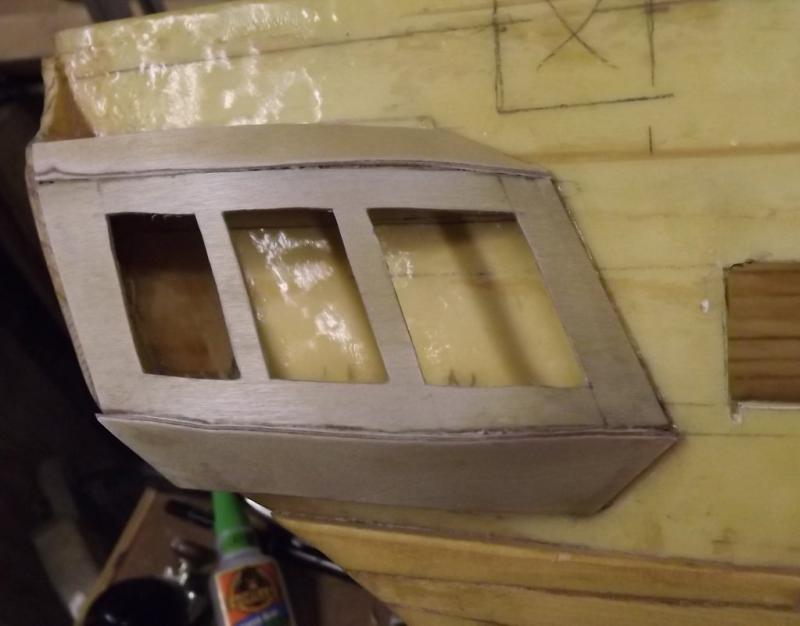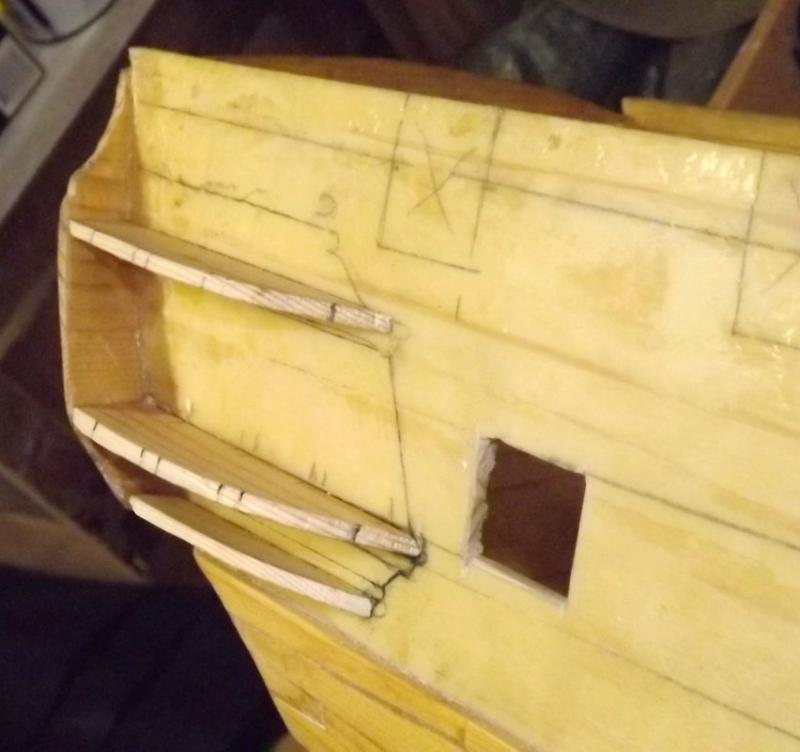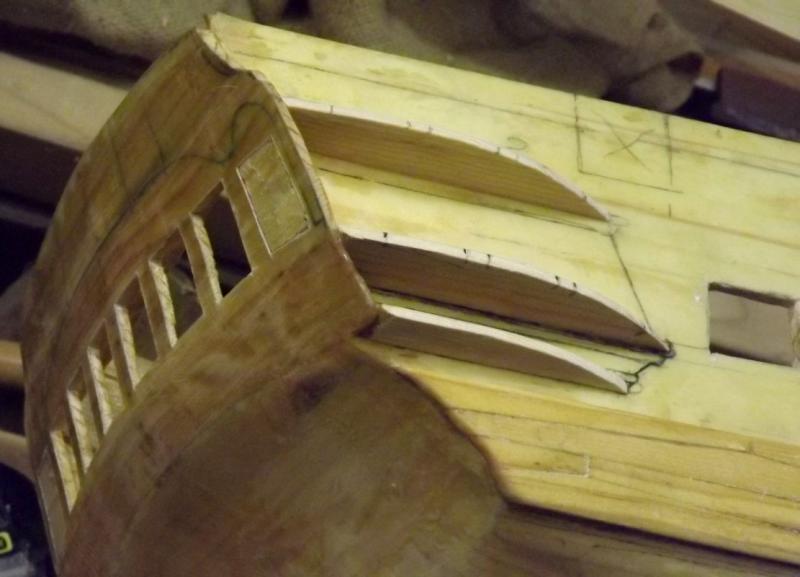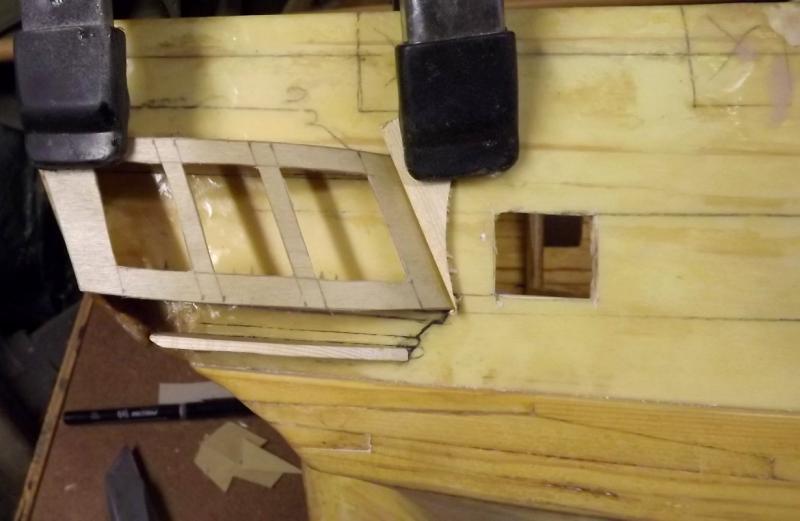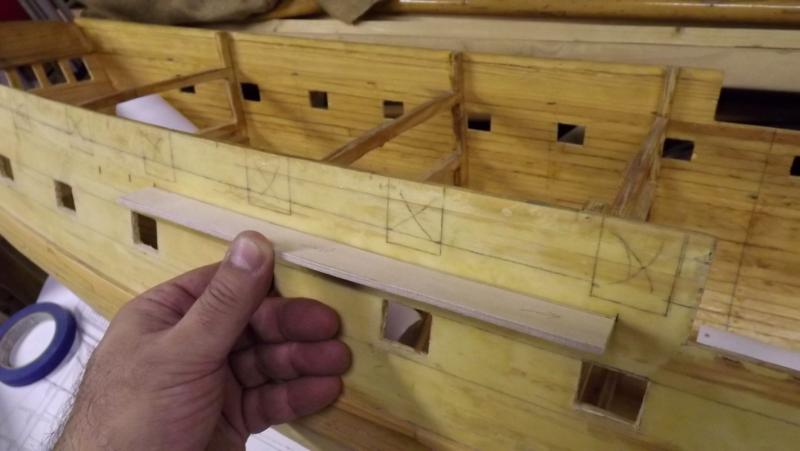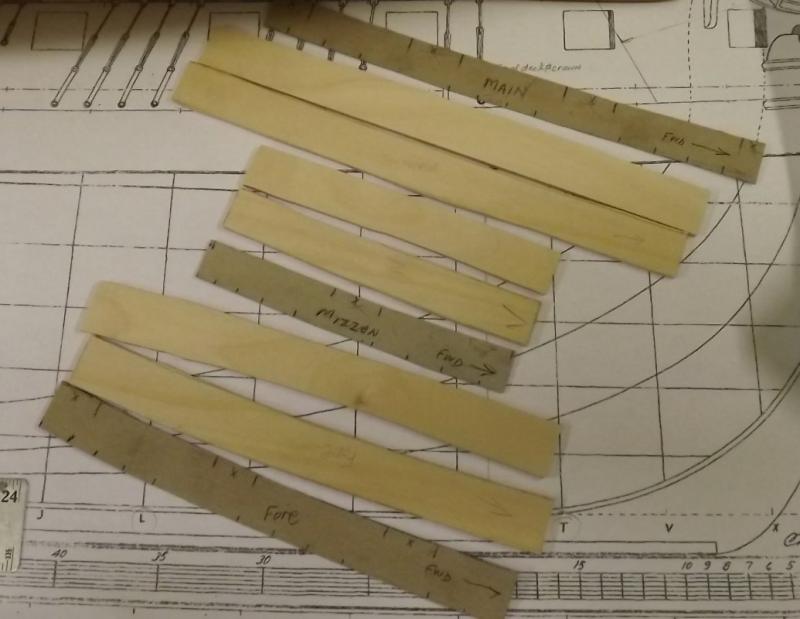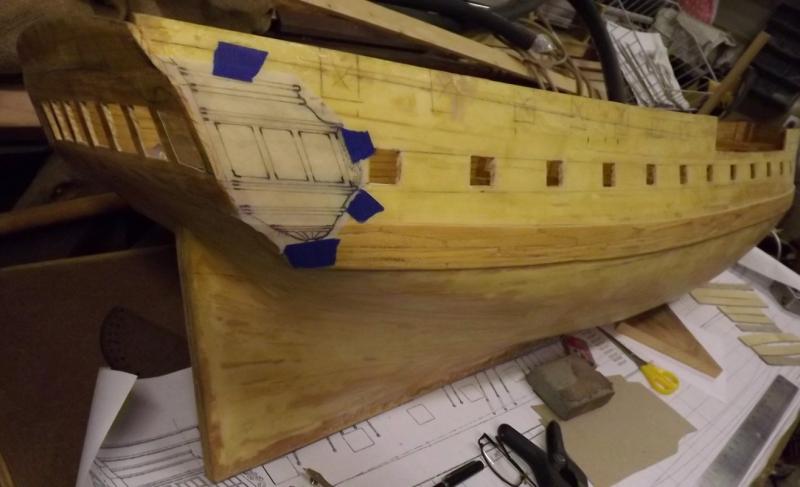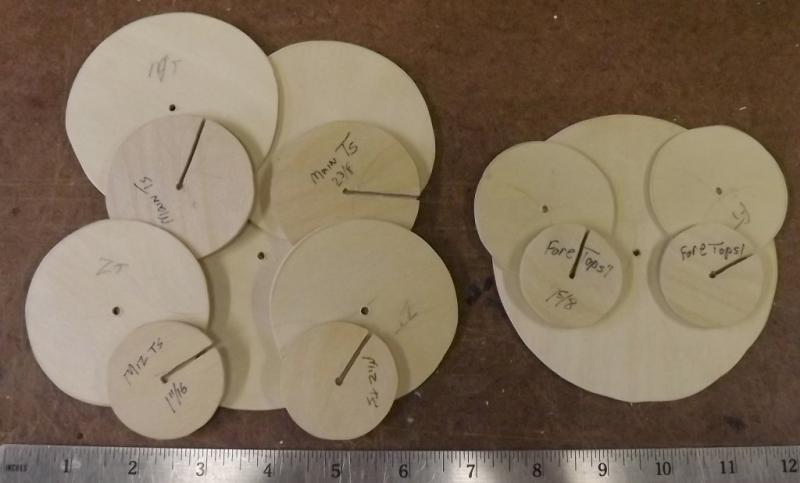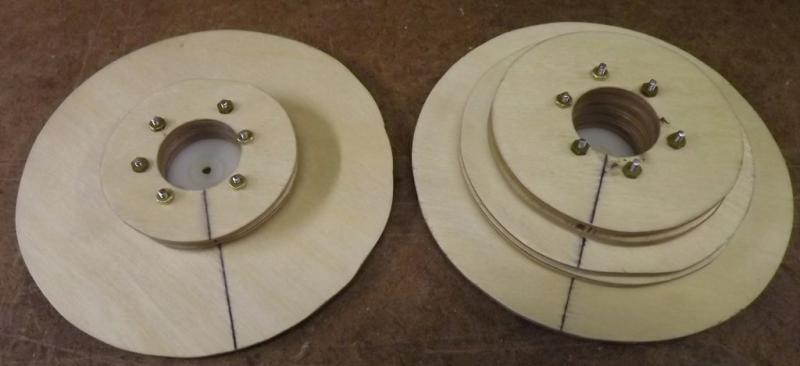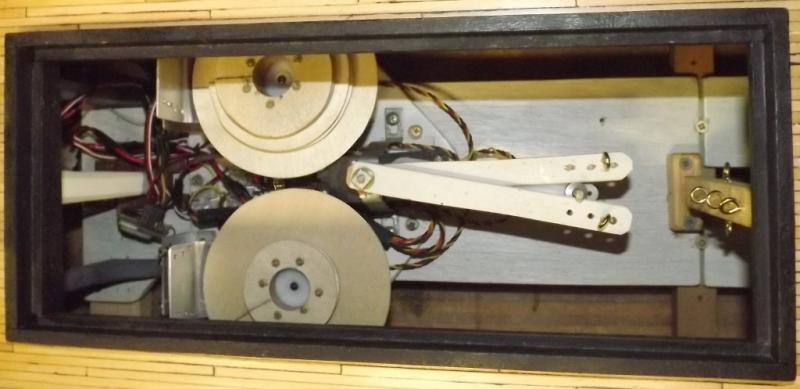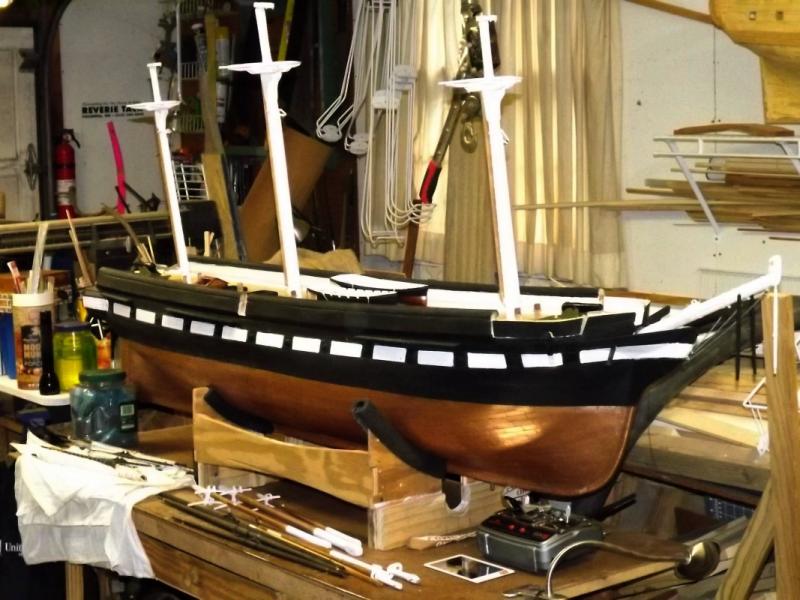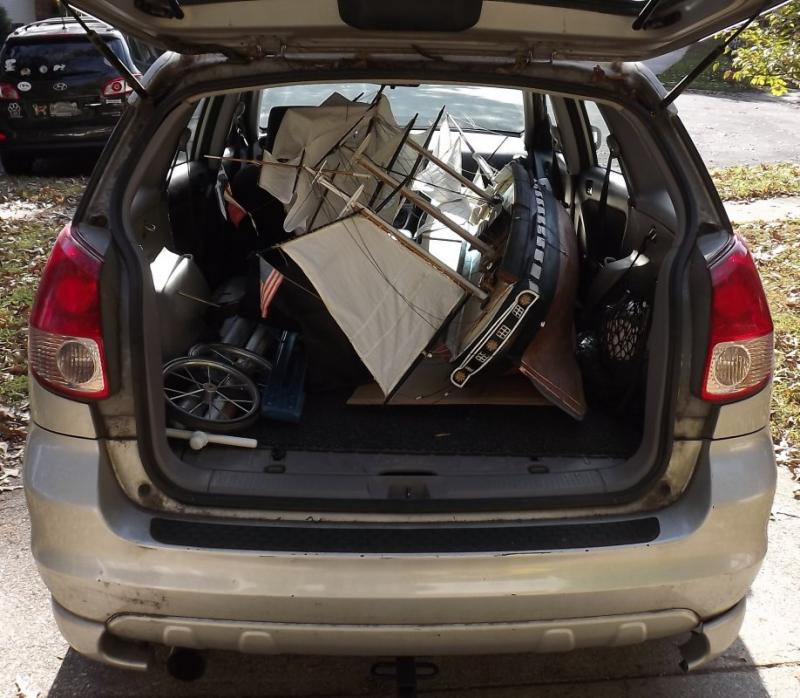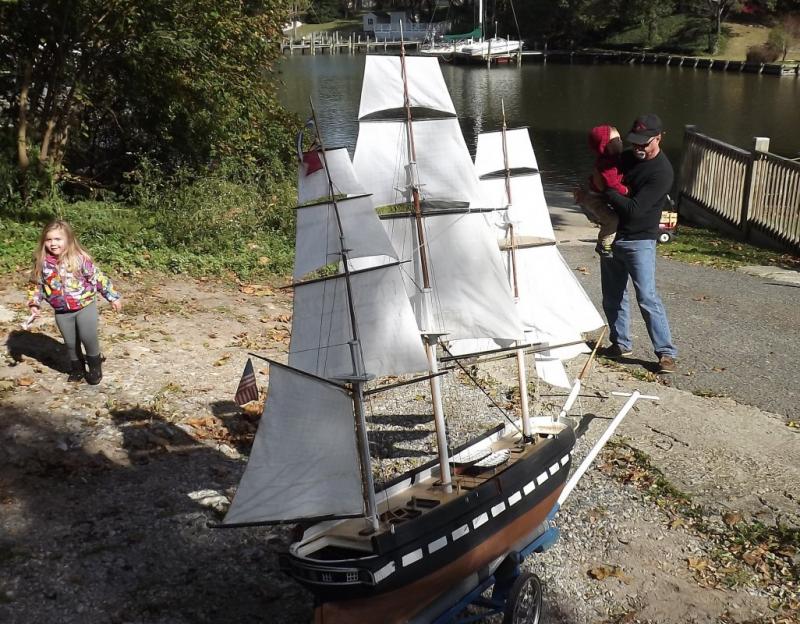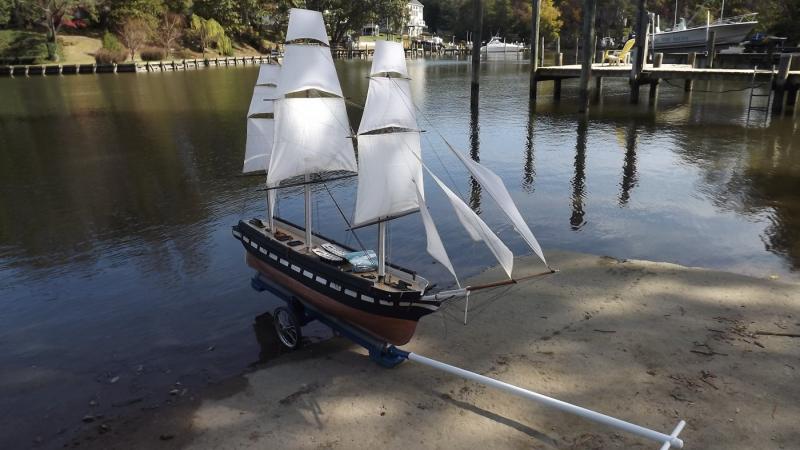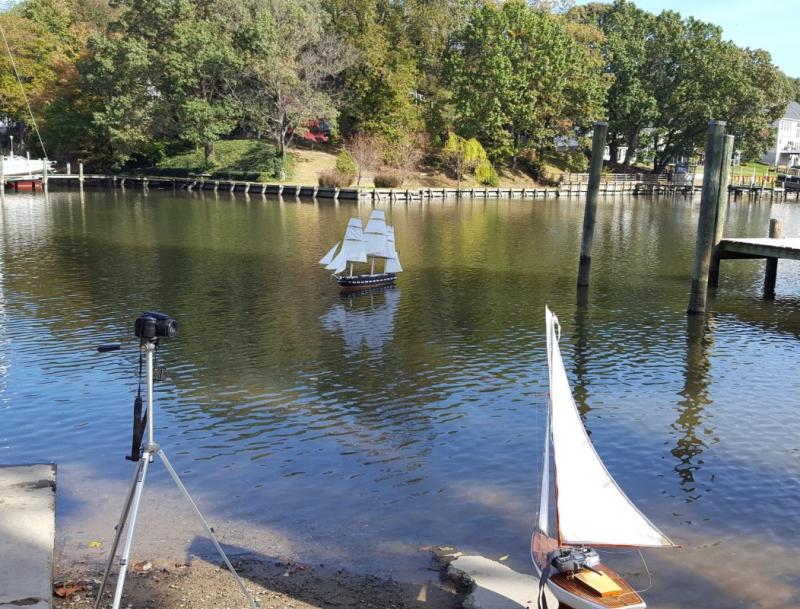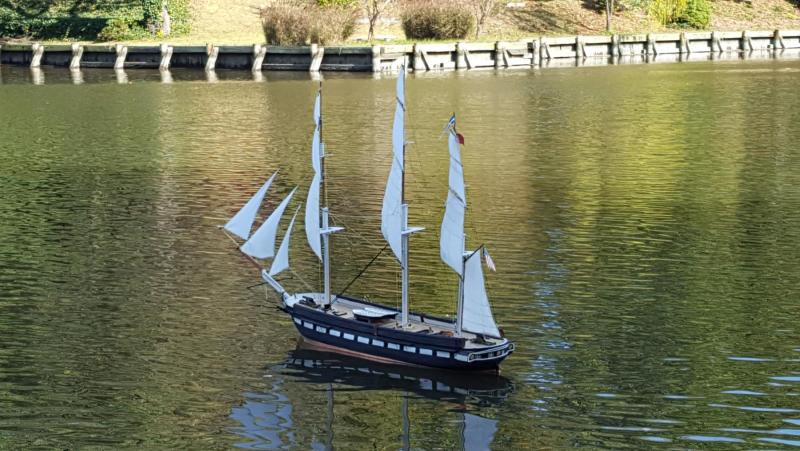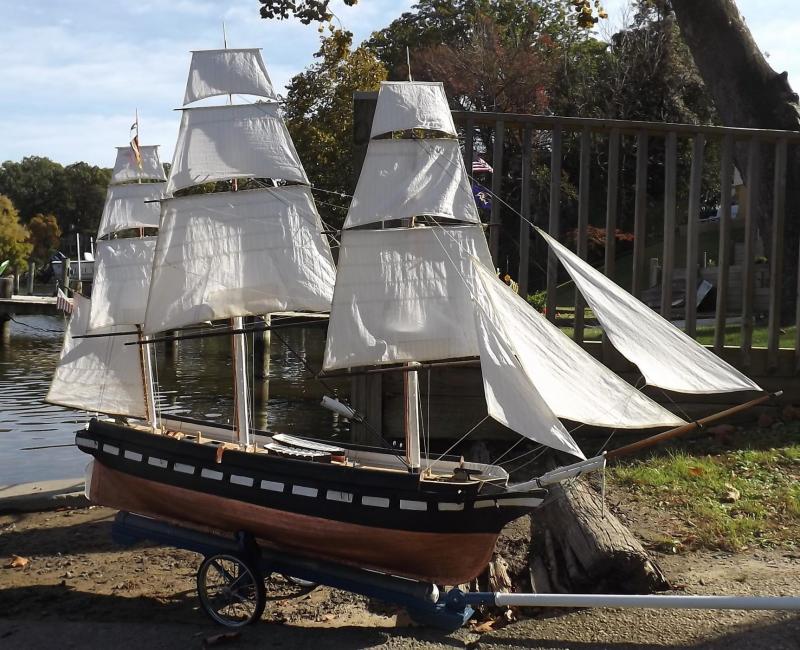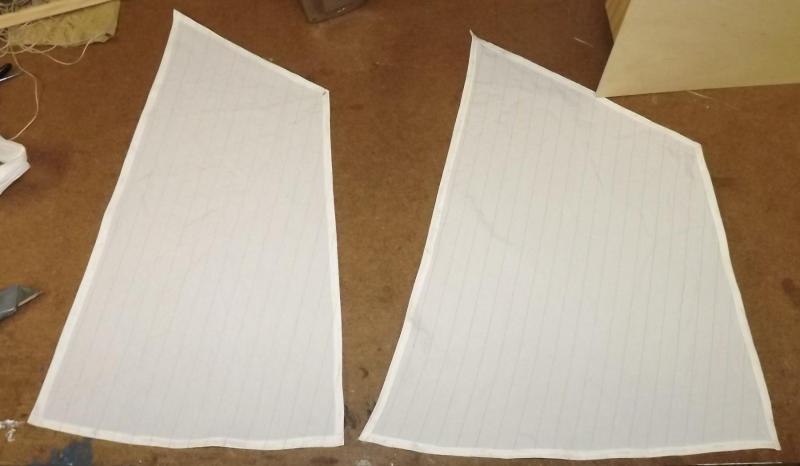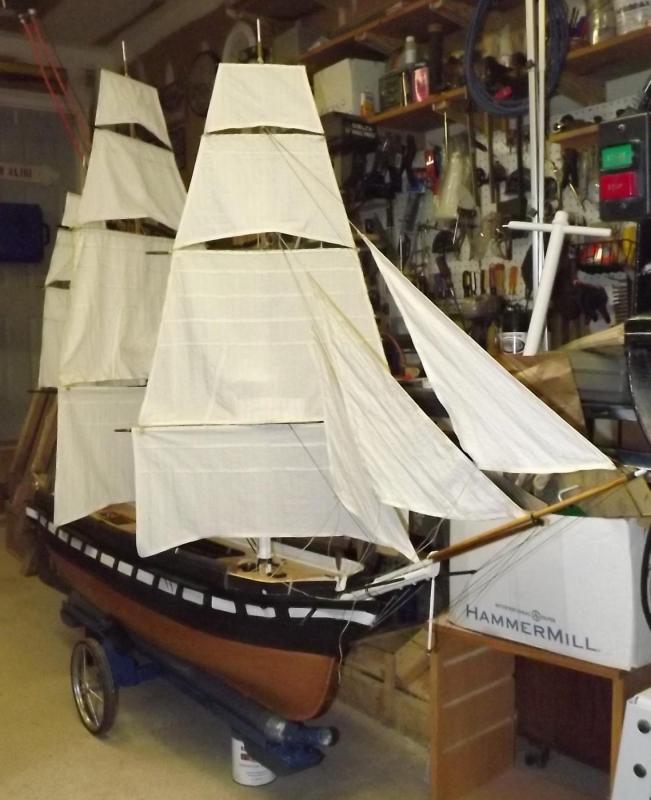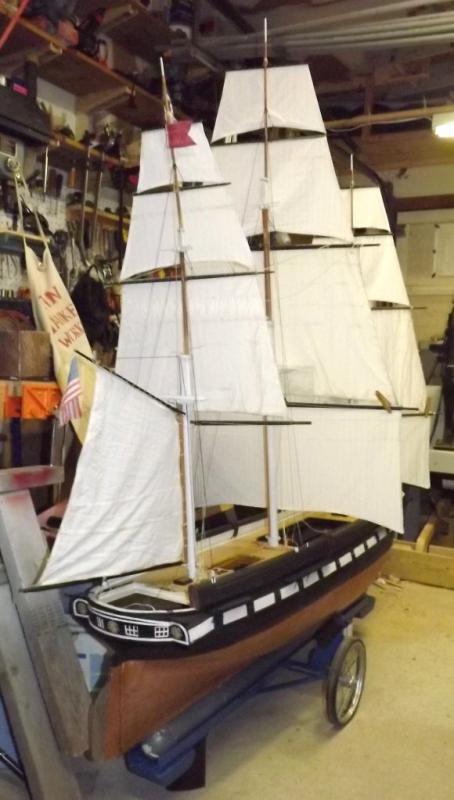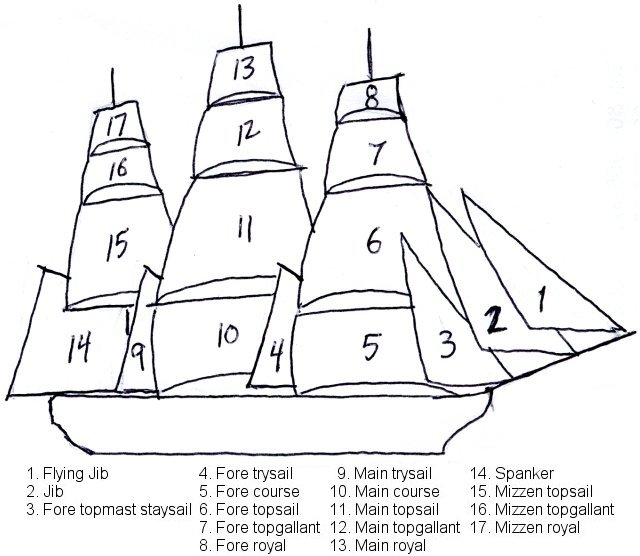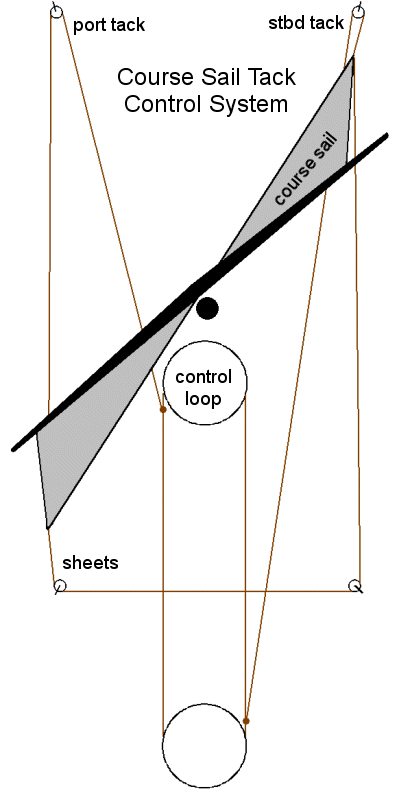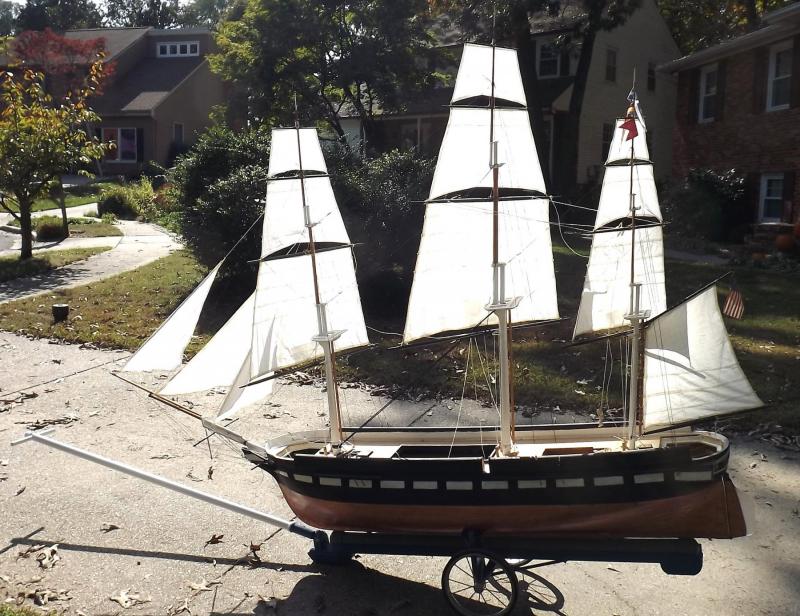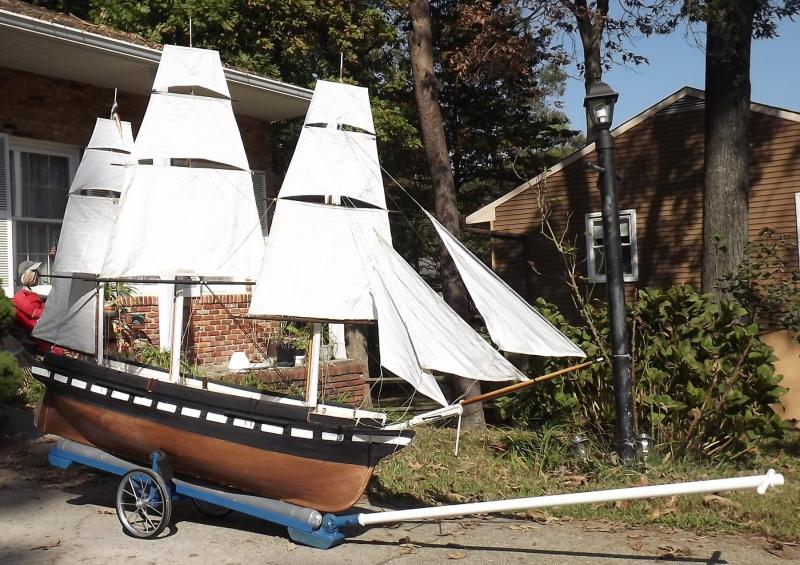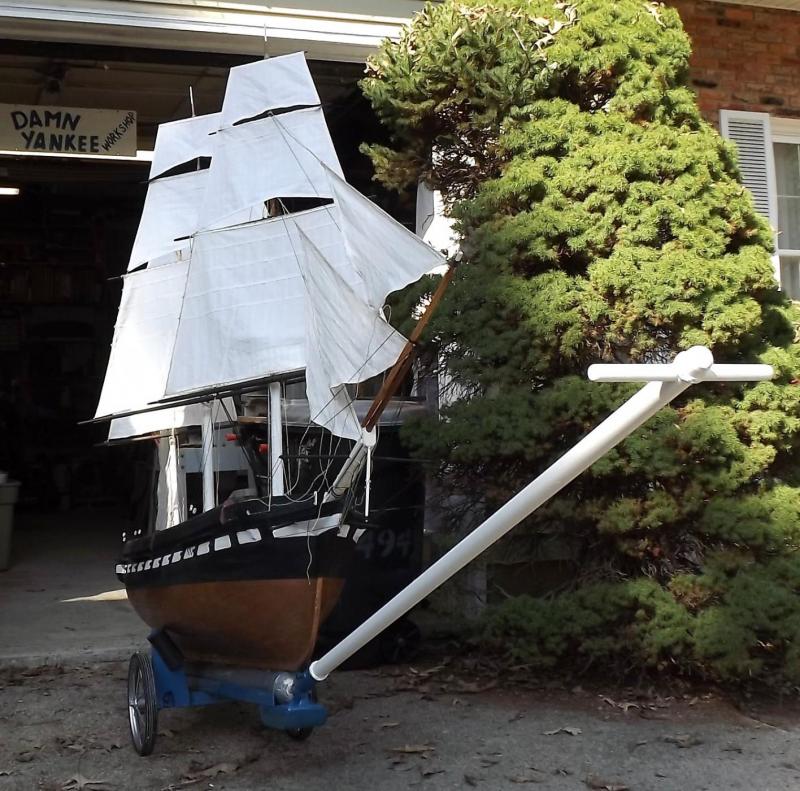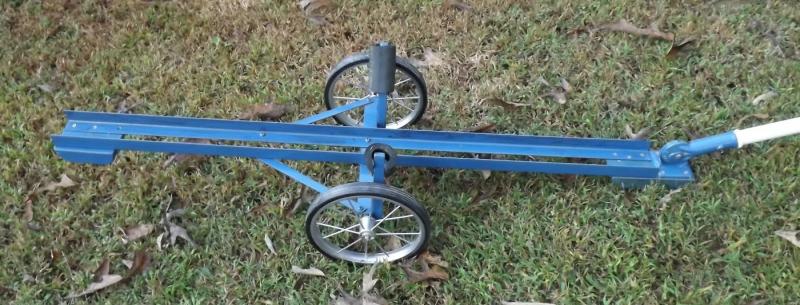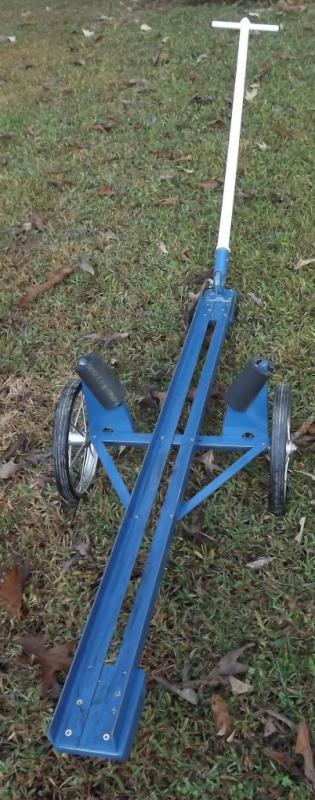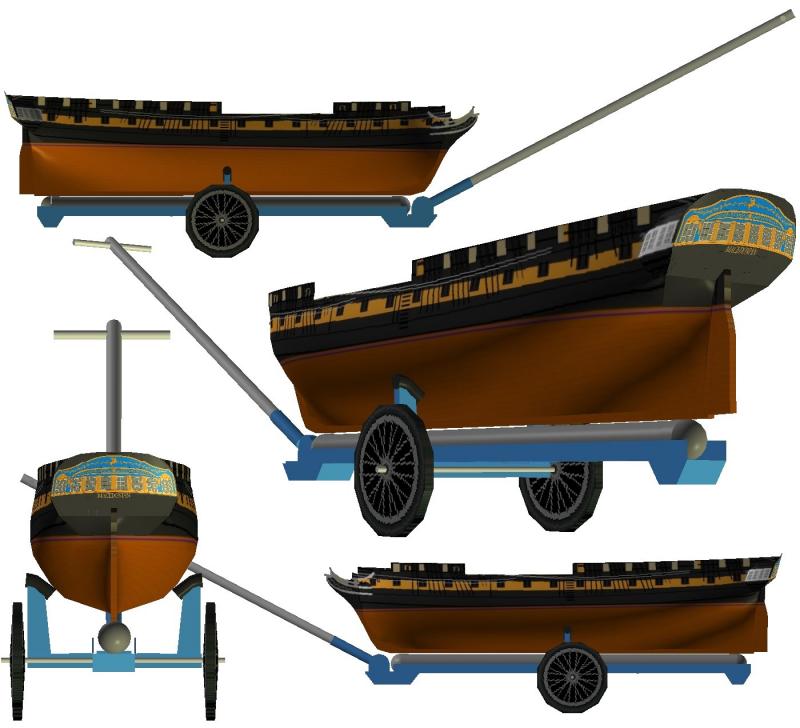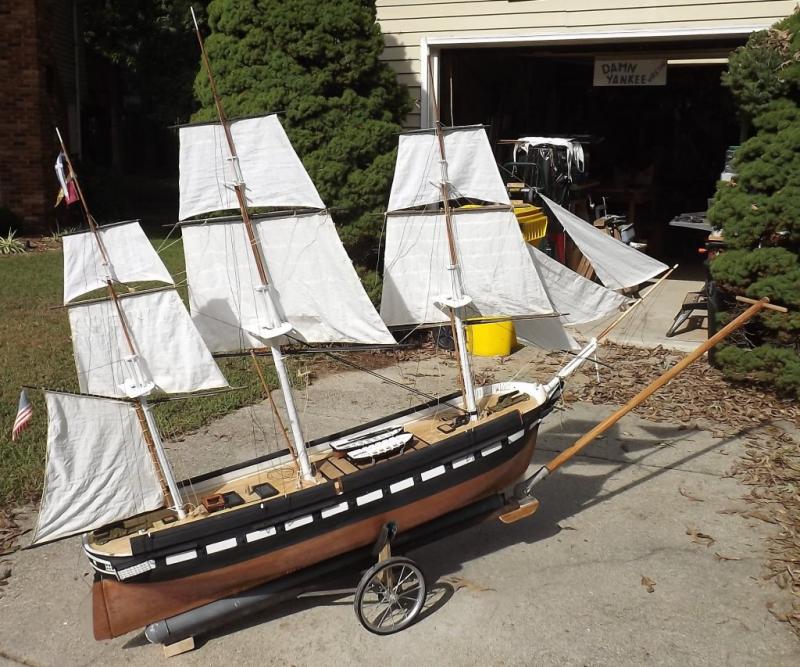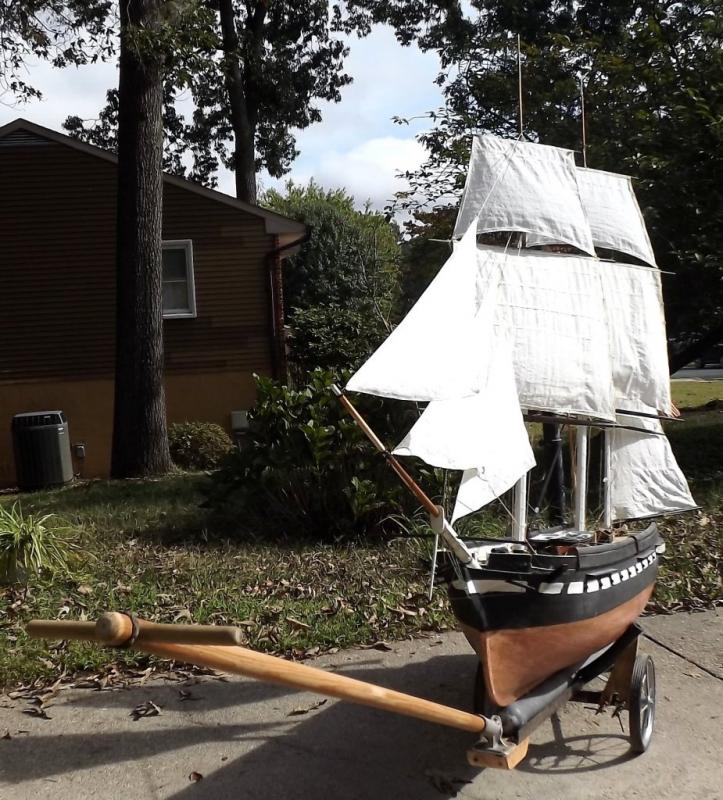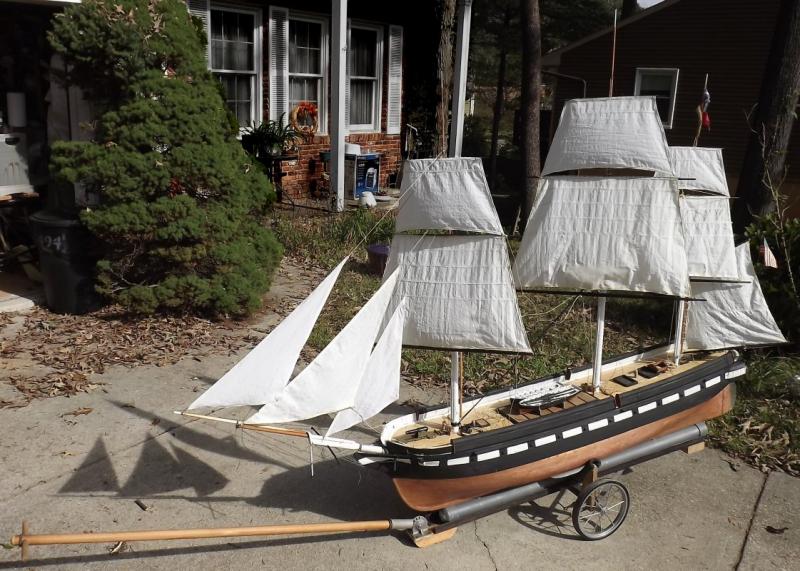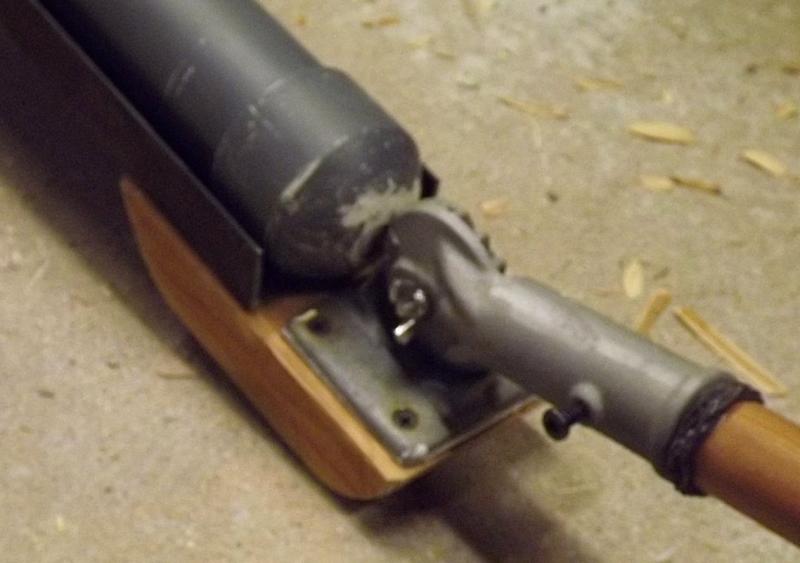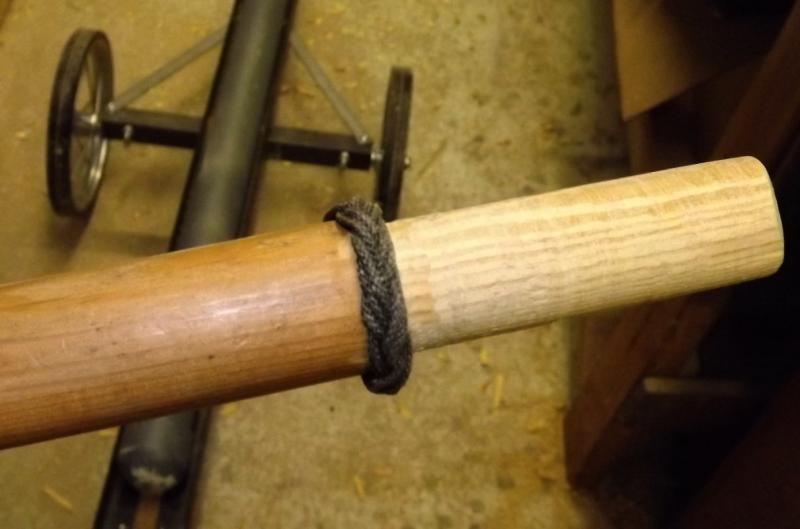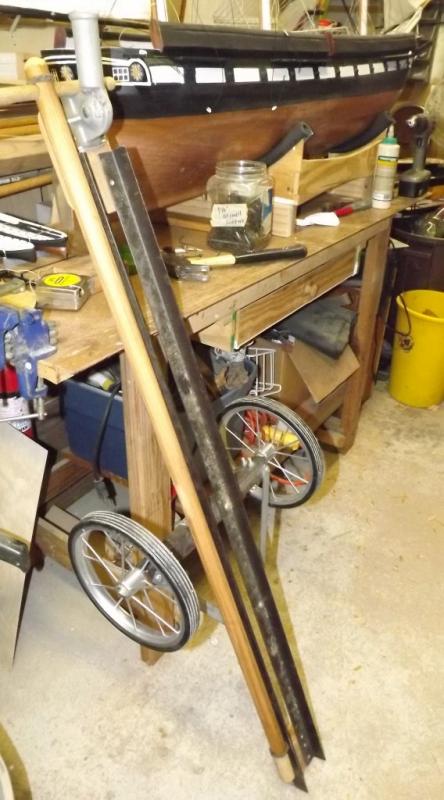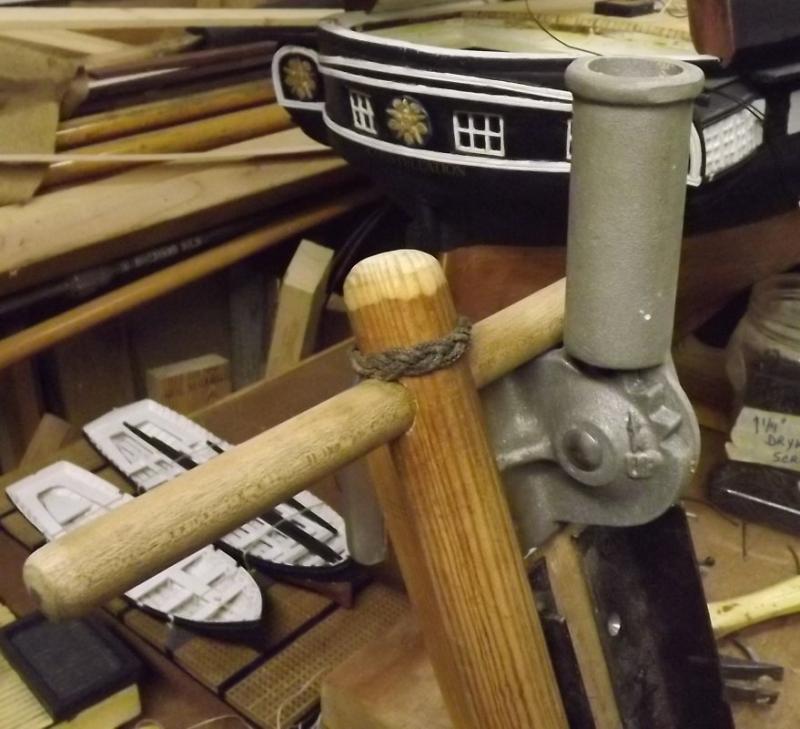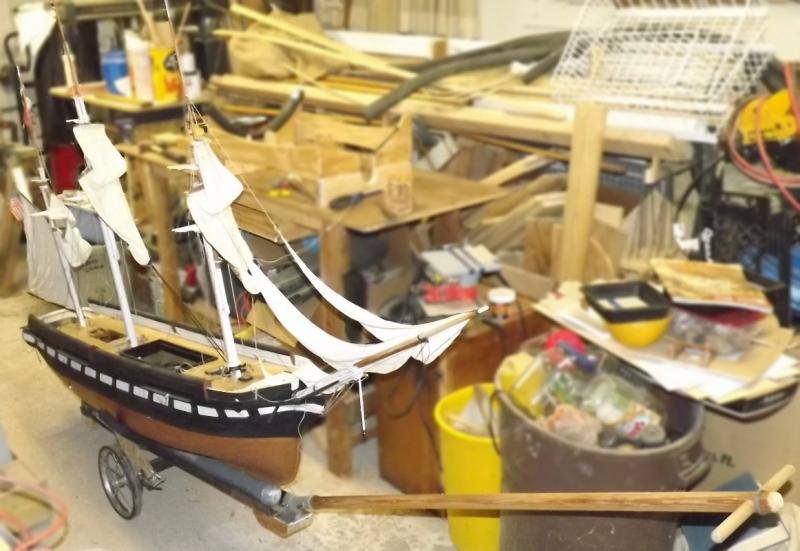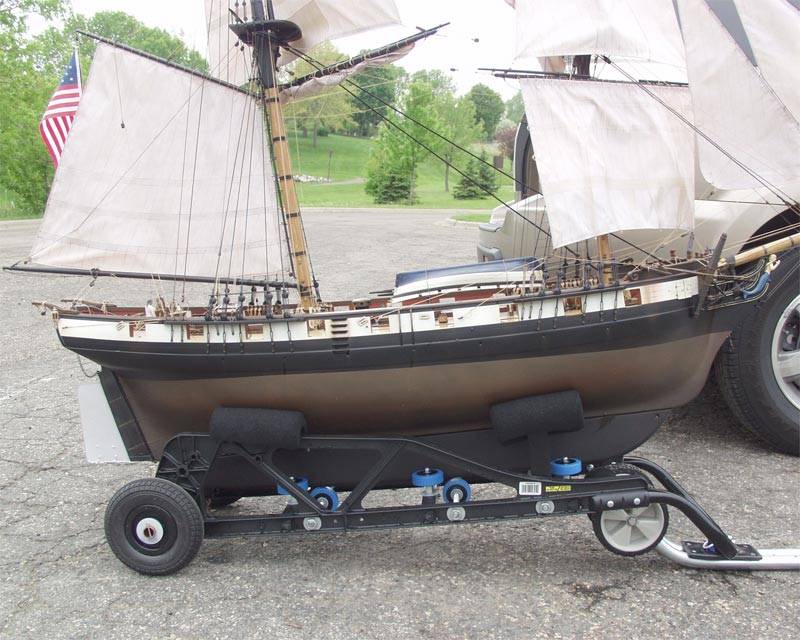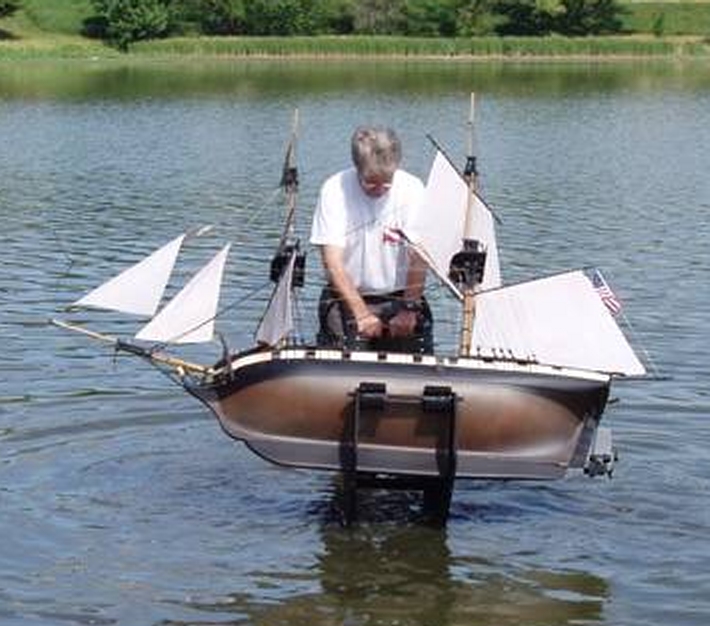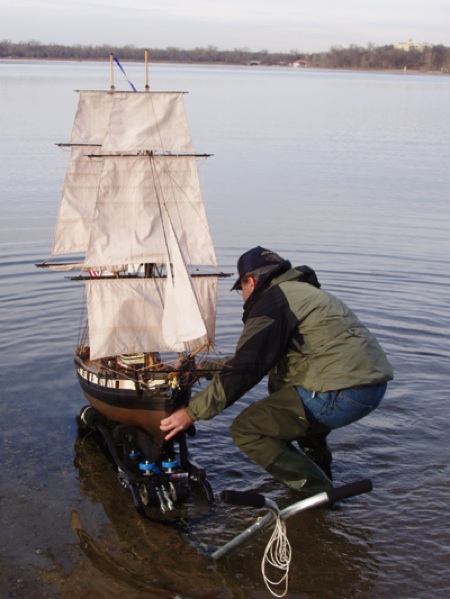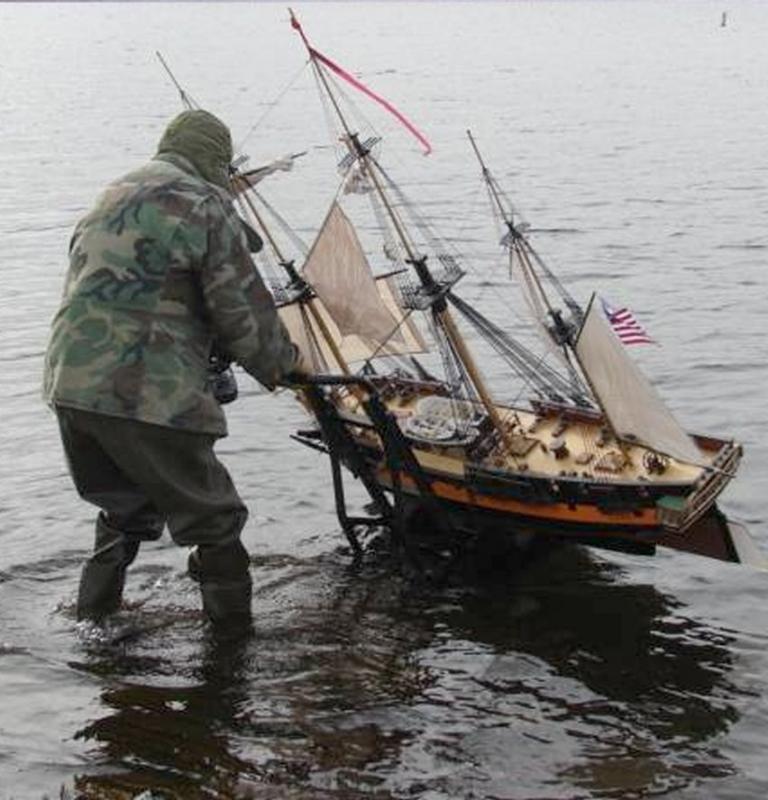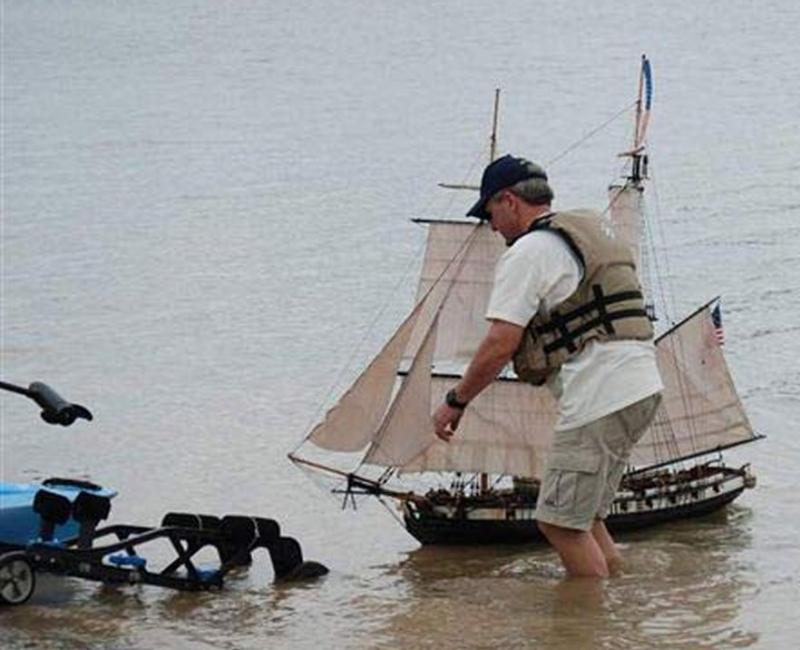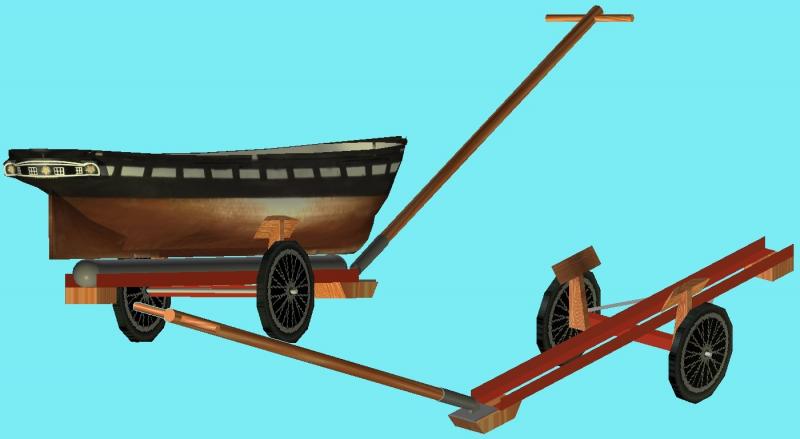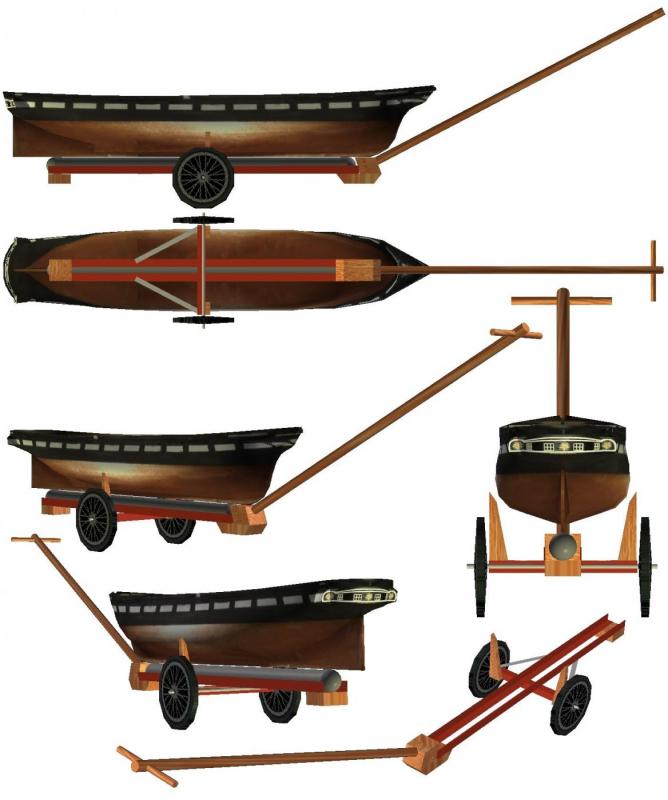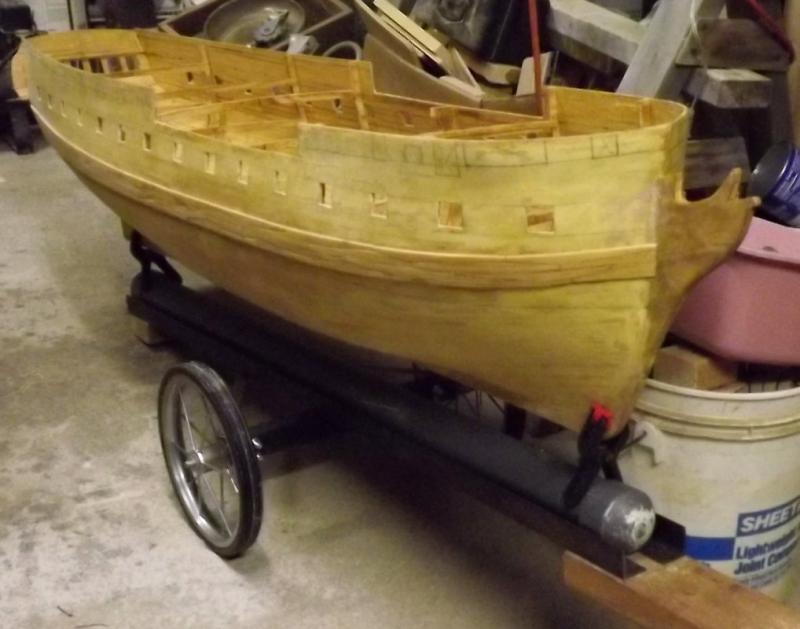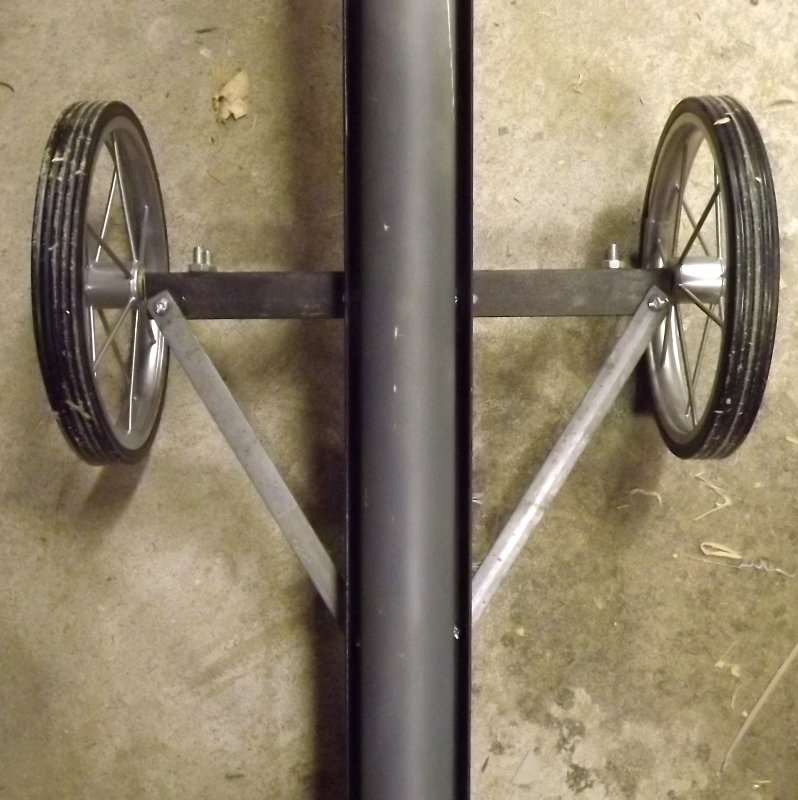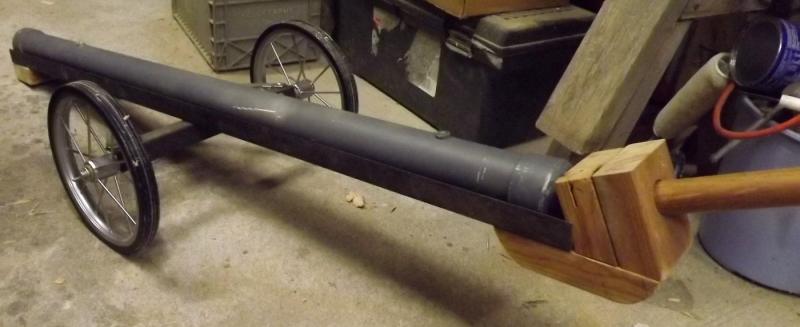-
Posts
874 -
Joined
-
Last visited
Content Type
Profiles
Forums
Gallery
Events
Everything posted by JerryTodd
-
Sail bundles anyway, not set and drawing.
- 648 replies
-
- niagara
- model shipways
-
(and 1 more)
Tagged with:
-
There's photos and video online of them up-rigging and down-rigging Niagara, you could sort of diorama a scene from one of those, hauling a bundled sail up, or down, people aloft bending, or unbending another sail. Gives you a reason to only have a few sails and some bare poles mixed.
- 648 replies
-
- niagara
- model shipways
-
(and 1 more)
Tagged with:
-
I know, she dresses up, goes out for a sail, and gets ignored. Not so, you see I made a new set of winch drums, and while the glue sets up on Macedonian I've been installing jack-stays on Constellation's yards. The main tops'l yard was already done, I've got the both course yards done, three tops'l yard, and two t'gallants done so far. Drilling holes in the yard for the eye-pins on the drill press. I use a shooting board with a V-groove I use for planing the spars when I'm making them, to hold the yard for drilling. Line up the bit with the bottom of the groove and the mark on top and you're drilling right through the center. The "eye-bolts" on the left are finer gauge copper and I don't think are up to the task so I use the eye-pins on the right that I get from Bluejacket. I use the .032 brass rod for the jack-stays. It's a little over-scale for Constellation but not too awful, and it does the job. I put a 90° in one end, thread the rod through the eyes, which are about 24" apart in this scale (5/8"), bend the other end back, and snip off the excess with flush cutters.
- 553 replies
-
- sloop of war
- constellation
-
(and 3 more)
Tagged with:
-
The port side is caught up with the starboard side now, and I did a LOT of sanding of the clumpy epoxy on the port side. There's some filling to do, and the rest of the quarter galleries to do. I also need to notch the channels before I permanently install them. Still more to do, but I'm much closer to getting some paint on her.
- 97 replies
-
- macedonian
- frigate
-
(and 2 more)
Tagged with:
-
Please, Omega, try not to be so critical of my work - you'll give me a complex. Assembling the port side gallery, and moldings. I also rough cut those little channels for the t'gallanet/royal back-stays. The epoxy on the port-side wale set kind of lumpy and is gonna take some major sanding effort, like belt-sander effort.
- 97 replies
-
- macedonian
- frigate
-
(and 2 more)
Tagged with:
-
There's whole books on hydro-statics and stability, but to put it as simply as possible, on a scale model, internal ballast is not enough, as this fellow learned: You simple can't get the center of gravity low enough within the hull. The more weight you add, the higher the CG moves as you're stacking weight up inside. Because Macedonian and Constellation have long flat-ish keels, the best form of external ballast is a bar or tube. I use a tube and would gladly use a lead bar instead if I could gather the gumption to cast such a beast. Some folks use fins. A fin moves the weight further down, like moving the skinny kid further from the balance-point to balance the fat kid on the other end of the see-saw. Here's Stad Amsterdam a model comparable in size to mine. She uses a fin keel that you can see being installed in this video. https://youtu.be/Yj3EBwU6Elo?t=152 If you watch her sailing you see she still heels way over despite the fin; because she's showing too much sail in what are basically scale storm conditions. When it's blowing 20+, you're pushing into scale hurricane winds! Fins are deep. In that video they're launching at a bulkhead, and it takes two people to do the job. I'm launching most of the time at a shoreline or ramp. With a fin like that I'd have to wade out to water deep enough to launch the model. By using a ballast tube, my launch-cart is basically a boat trailer and I hardly have to get into a foot of water to launch, as you can see at the beginning and end of my video... I can also launch and retrieve all by myself, without help. Whatever sort of external ballast used, there's one common feature that sells it hands-down; it's removable. By unscrewing two threaded rods, I can easily detach the model from 42 pounds of ballast. I can lift the model and move it around alone, and safer for me and the model. Constellation still needs about 15 pounds of ballast added internally to get her to her waterline and trim her or she sits about 2 inches too high. I also have easily removable t'gallants and royals, the courses can be bunted up, and the model can essentially be under tops'ls and jib in a few minutes if the wind's too much for her plain sail suit.
- 97 replies
-
- macedonian
- frigate
-
(and 2 more)
Tagged with:
-
Maybe not in 1:24, but your diorama's been built. I'm working in 1:36, I don't have a vehicle I could fit a 1:24th scale version into. The fellow that printed the masters for my guns is building one of the SC&H Cruiser class brigs as the Scorpion, and intends to build another Lively class frigate, the Spartan, in 1:24 scale. That will have a 77 inch hull compared to my 59 inch hull. Scorpion in her first in the water test Back to Macedonian... I really want to get some paint on this girl before I take her down to the creek for her first dip, but I need to get molding and such on her first. I save old utility knife blades just for making molding scrapers. This one I made today with two patterns. The molding was applied along the sheer-line, with gaps for the channels. There's another line of molding above that. Here the channels are friction fit and sanded to fit tight against the hull.
- 97 replies
-
- macedonian
- frigate
-
(and 2 more)
Tagged with:
-
Sheathing commences on the starboard quarter gallery. Don't worry, I have cardstock patterns for everything so I can duplicate all this on the other side.
- 97 replies
-
- macedonian
- frigate
-
(and 2 more)
Tagged with:
-
- 97 replies
-
- macedonian
- frigate
-
(and 2 more)
Tagged with:
-
- 97 replies
-
- macedonian
- frigate
-
(and 2 more)
Tagged with:
-
Entrance of the Queen of Sheba and a couple of others I'm actually not familiar with. I spent more time searching for music that fit and that YouTube wouldn't get all wadded up about, than I did editing the video. My aircraft ply order finally arrived so I got right into making a new pair of winch drums: The drums are 1/8" ply, the flanges are 1/16" ply. After gluing them up, they got a couple of coats of spray lacquer for good measure. I reused the plastic servo attachment disks and threaded rods from the last drum failure using the existing out-of-whack holes. Set in place waiting for a rig to grow around them again.
- 553 replies
-
- sloop of war
- constellation
-
(and 3 more)
Tagged with:
-
I almost feel bad for down-rigging her already, but there's bolt-ropes to sew, chain plates to make, and rope to walk so that next time she sails it'll be with a permanent rig; shrouds, stays, etc.
- 553 replies
-
- sloop of war
- constellation
-
(and 3 more)
Tagged with:
-
Well, I managed to get a sail in before it got cold. I had a short list of items to "test" with this expedition... Boat will fit in my Toyota Matrix. Launch trailer worked well, needs some tweaks to keep the boat from sliding off the end before you want it too, and there's too much slop in the flag-bracket handle holder. Self-tending bowlines worked well. Bracing only the tops'l yards worked well. Jib-sheeter worked well despite not being adjusted as best it could have been. Finally sailing in open water again where she was intended to be since I started her in 1999. I held my breath every time a gust made her heel. She did great. Remember to bring extra batteries for the camera next time. I brought tools, line, tape, glue, reading-glasses, tripod, and the camera batteries died. Fortunately Captain Rooney was on hand and took some stills and video with his phone, while sailing Son of Erin and keeping an eye on the two grand-kids - but he's a tug captain and used to multi-tasking. Here's some pics from today's outing. and 16 minutes or so of video...
- 553 replies
-
- sloop of war
- constellation
-
(and 3 more)
Tagged with:
-
I've seen several servo hacks designed to have them run continuously, such as you might want for a winch. If I did this to a pair of cheap servos, I could Y them off the brace winch servos and they should operate together. This is something I'll experiment with down the road. Today I dunked sticks in ammonia and wrapped them around a tube to make hoops for the two trys'ls. While that dried I went to a friends and helped him eat the crabs he caught this morning. 26 more hoops like these for the driver It's been running in the 80's here for the past week, temperature-wise; that just broke this evening with rain, wind, and dropping down to 60° (f). Ready or not, when the these winds blow out, I'm hauling the boat out and putting her in the water. I want some pictures of her afloat with all her sail's aboard, and I want to test launching and retrieving with the new cart a few times.
- 553 replies
-
- sloop of war
- constellation
-
(and 3 more)
Tagged with:
-
I hung the courses (with clothespins) after hemming them. While in hemming mode, I did the last two sails in her suit; the main and fore trys'ls. I burned all the grommets in with a soldering iron since this pic was taken. These sails (courses and trys'ls) will be brailed up as I don't have a good way to control them via RC. The courses I hope to figure out eventually, but the trys'ls won't be happening. I'll shake them out for static displays. I want to use the tacks to haul the clews forward as the best control when close-hauled. The best way to do that is with a trolley system, like a clothesline, with a winch running a continuous loop and the tacks attached to that loop. The sheets just run through the model from one clew to the other. There's a couple of problems here. The main and fore sails are controlled separately, so I'd need TWO of these set-ups inside the model, which accents the second problem; space (room, accessibility through hatches, and the spider's web of control lines already in place. A more compact solution would be a "linear actuator" or basically a threaded rod spun by a motor with the tacks attached to a shuttle that travels on the rod. Either way, the trolleys or actuators would have to be as long as at least half the length of tack I need to haul, which would probably be around 6 to 10 inches. The real thing here is, besides adding two more electric motors to the load and dealing with directional control, etc; syncing it with the winches that control the braces for the same mast. Another much simpler way of dealing with the courses, is the "Bentinck-boom," which is simply a yard at the bottom of the sail. The foot of the courses gets pulled around like the rest of the yards not directly controlled. Rather than an actual yard, it would be a rod set into the foot of the sail to have the same effect. This is ok if it's in a pocket and I can remove it easily to clew up the sail when I want to. Another version of this is to use stiff wire or rod made to appear like the clew-lines, that hold out the clews as the boom would. This seems it would be more difficult to make removable when I want clew up the sail than the boom version would. Soooooooo.... I guess I'll wind up going with the "Bentinck-boom" rod in the foot of the sail idea, but I'm not going to worry about it until I get the rope-walk operating and can get down to properly rigging this beast.
- 553 replies
-
- sloop of war
- constellation
-
(and 3 more)
Tagged with:
-
Put the boat back on the cart and added the royals. Still working on controls before I take her down to the creek and see if all this effort was worth the effort.
- 553 replies
-
- sloop of war
- constellation
-
(and 3 more)
Tagged with:
-
I hand royal blue paint, so much for light blue. I opted for white on the handle as a safety thing; visibility and all that.
- 553 replies
-
- sloop of war
- constellation
-
(and 3 more)
Tagged with:
-
The cart I built in Constellation's logs will also be used for Macedonian, here's a little artist's rendering...
- 97 replies
-
- macedonian
- frigate
-
(and 2 more)
Tagged with:
-
I was thinking I could mount a caster on the back, connect it to the rudder, and sail her down the street.
- 553 replies
-
- sloop of war
- constellation
-
(and 3 more)
Tagged with:
-
Still have to finish the side supports. the first attempt is mounted with C-clamps here - but this looks like it's gonna work.
- 553 replies
-
- sloop of war
- constellation
-
(and 3 more)
Tagged with:
-
I thought I had one of those flag pole brackets from when I repaired one of the posts on the porch - I did, in fact it's the exact same design as the picture I posted before, and it's perfect for this. I had to shave 1/8" all round the end of the handle so the 1-1/4" pole would fit into the 1" socket. I also tied a turk's head at the shoulder and above the t-handle to help against splitting - I can't remember how long it's been since I tied a turks-head - it took a while to remember how.. I played around with side supports - just cutting some basic posts from treated 3/4" board and holding them on with C-clamps as I figure out what works best.
- 553 replies
-
- sloop of war
- constellation
-
(and 3 more)
Tagged with:
-
A note on launching carts.... For a working model, how you transport it, get it over to, into, and out of the water is as much a part of the model as hull, rig, and controls. The more work taking your model out to sail is, the more difficult it is, the more likely you'll just not want to fight that battle again, and your model won't get sailed. I developed my idea from the trials and tribulations of other large model sailors I know; two in particular. My conclusions and subsequent design I think are confirmed by Brian Clark's Killingworth, shown previously, which he built back in 1999-2000. Ray had the 1:24 scale HMS Surprise kit from SC&H which is about the same size as my Constellation, a little taller. He used a hand-truck based system that came with the kit. The wood cradle is large and bulky to support the 90+ pound model cantilevered off the cart as it is. The upright portion of the cart also has a lot of potential to hit and damage the rig, especially during retrieval of the model. Ray also told me the inflated tires and wood cradle made the cart want to float, preventing him from just parking it and bringing the boat to it - he had to hold onto the cart all the time in the water or it would fall over. Dan has the SC&H Grasshopper kit, also 1:24 scale; which he's modded to be the US brig Syren. He too started with the kit's supplied hand-truck, the same as the Surprise kit, with all the same issues. Note how leaning the cart back puts him IN the rigging! Dan modded his hand-truck into a trailer style cart, but the wheels being at the end, it doesn't balance on them as mine does. I think this will be a factor in the cart's performance. At a glance, it would seem the hand-truck's main advantage is allowing you to launch at a bulkhead or off a dock - and I considered this, but it's a false assumption. Access to many floating docks are via a gangway with railings which you won't be able to get an 8 foot long model down sideways. Then, trying to control lowering a hand-truck like those shown above, down even a one foot bulkhead or dock with a 100 pound model on it, getting the model off the cradle and away, while trying to hang on to the cart and retrieve it - then attempted to get the model back onto the cart as you dangle it off the bulkhead, without knocking the rig to bits... I'm sure you can imagine the Three Stooges episode this would inspire. Consider too that I'm after something I can handle alone, as I most likely will be.
- 553 replies
-
- sloop of war
- constellation
-
(and 3 more)
Tagged with:
-
Hey John. My first concern with putting a caster on the back was dunking it in the water - all those little bearings and stuff would have me spraying WD-40 till everyone died of the fumes. The wood blocks also act a bit like tail-skids, so it's not as likely to move when I sit it somewhere, that somewhere very likely to be inclined to some degree. The thing is intended to be a little tail-heavy, so when I park it in the drink to put the model on, the back end isn't sitting up waiting to hole the boat, but instead is sitting down and being a nice inviting ramp (that stays put). I've stood my 260 pounds on it, walked it from end to end like a teeter-totter, and it hardly flexes. It weighs about 20 pounds by itself, Constellation with her ballast weighs about 100 pounds, displacement calculations put her at 98 (I plan to get a more accurate measurement when I go to move her onto the cart). Weight will be an issue if the ground where I'm launching is soft, cause these narrow wheels will tend to sink in. The places I intend to launch her are firm or concrete boat-ramps, so I'm not too concerned there. If I find some fatter wheels, like those on the back of a tricycle, I will swap them out. I updated the 3D model to get some idea of the side supports. Here it is with a preliminary idea of those, and the flag-pole bracket for a handle-holder. This model is now properly and more accurately scaled. The rods that hold the ballast to the model stick out of the keel about 5/8" and set into the couplings inserted into the ballast tube a bit like aligning pins. Because of this, I can sit the ballast on the cart, then sit the model on the ballast and thread the rods in without the model trying to fall off the ballast; ie: I won't need additional bracing for the hull on the cart. Being able to attach and separate the model from 42 pounds of ballast relatively easily is a huge help - and the easier it is to get her to, into, and out of the water - the more likely and more often she'll be sailed.
- 553 replies
-
- sloop of war
- constellation
-
(and 3 more)
Tagged with:
-
Braced the axle with some 3/4" wide metal I had laying about, and used bits of 2x4 to block the ends and make a receiver for the handle. The handle is a 1-1/4" diameter fir closet rod with a 3/4" x 9-3/4" t-handle. Since Mac's bare hull is much easier to move around, I placed it on the ballast tube to get an idea of how this would look... I also took some measurements and made my 3D model more accurate so I could use it to figure out the side supports... I think some 3/4" thick pieces bolted to the axle support will work. I'll put a cross-piece with some padding at the top of them, and that should work out pretty well. In the model you can see the block the handle goes into was too tall, and I chopped it off so the hull would clear it. The actually makes the hole for the handle lower, which I can't do on the real one, so I have to cut off some at the bottom and the top of those blocks. If I can't do that, I'll make a new set-up with hole for the handle underneath the channel instead of above it. Hmmm, maybe I can just go with one of these? I'd have to shave the end of the pole down to 1", but I think this could work, and it's adjustable!
- 553 replies
-
- sloop of war
- constellation
-
(and 3 more)
Tagged with:
-
I could only afford one blade and despite it's claim to cut through steel up to 5/16" thick, this 1/8" thick steel made quick work of it. I managed to cut the cross-bar before it gave up the ghost. I drilled the bolt-holes and found some cable clamps to use as u-bolts for the axle. Drilled the axle for cotter pins and slapped together what I've got so far. I was going to mount short pieces of angle at either end to maintain spacing, but I may just use some wood blocks instead of angle-iron. The end on the ground is the back/stern end. This way I'll need to push down on the handle to move the cart, instead of lifting it. I'm a bit surprised the neighbors didn't call the cops thinking I was building a cannon. I have a wood closet pole for the handle, but haven't determined yet how I'll attach it to the cart. I want it removable. I'm thinking a wood block with a hole for the handle, and one for a pin to go through to hold that handle in place. That seems simple enough. On the wheels I think I'll go with hitch pins instead of cotter pins, then I can pop off the wheels easily without tools and it'll take up less space in the car.
- 553 replies
-
- sloop of war
- constellation
-
(and 3 more)
Tagged with:
About us
Modelshipworld - Advancing Ship Modeling through Research
SSL Secured
Your security is important for us so this Website is SSL-Secured
NRG Mailing Address
Nautical Research Guild
237 South Lincoln Street
Westmont IL, 60559-1917
Model Ship World ® and the MSW logo are Registered Trademarks, and belong to the Nautical Research Guild (United States Patent and Trademark Office: No. 6,929,264 & No. 6,929,274, registered Dec. 20, 2022)
Helpful Links
About the NRG
If you enjoy building ship models that are historically accurate as well as beautiful, then The Nautical Research Guild (NRG) is just right for you.
The Guild is a non-profit educational organization whose mission is to “Advance Ship Modeling Through Research”. We provide support to our members in their efforts to raise the quality of their model ships.
The Nautical Research Guild has published our world-renowned quarterly magazine, The Nautical Research Journal, since 1955. The pages of the Journal are full of articles by accomplished ship modelers who show you how they create those exquisite details on their models, and by maritime historians who show you the correct details to build. The Journal is available in both print and digital editions. Go to the NRG web site (www.thenrg.org) to download a complimentary digital copy of the Journal. The NRG also publishes plan sets, books and compilations of back issues of the Journal and the former Ships in Scale and Model Ship Builder magazines.


